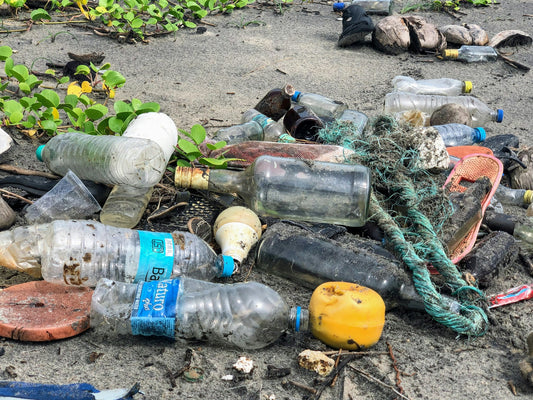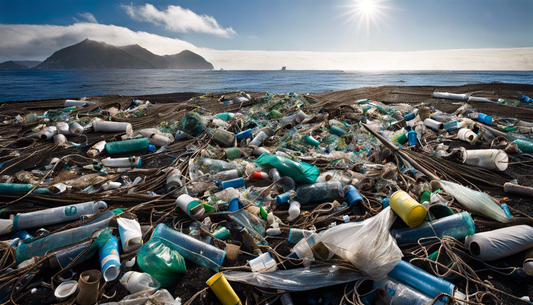Share
Fast fashion has become one of the most profitable industries worldwide. In 2021 it generated more than $91 billion US revenue and is expected to grow to $133 billion until 2026. But that stellar growth comes at a cost for the environment, and the exploited workers involved in the production of the fast fashion items.
In this article, we will focus on the environmental aspect of the fast fashion industry and how plastic became an essential part in its operations, from the production of synthetics to packaging, shipping, and disposal.
We will then explore the difference between fast fashion and slow fashion and provide some tips how you can ensure you buy your beautiful new outfit with a good conscience.
What is fast fashion?

Fast fashion emerged as a relatively new concept in the 1990s. ZARA, the Spanish clothing retailer introduced a unique business strategy of quickly reacting to big trends in the fashion industry and featuring low-priced lookalike products of popular high-end fashion shown in the big shows in Milan, Paris, London, and New York. ZARA added an element of artificial scarcity by producing smaller quantities and switching its complete collection every few weeks. The model was a booming success and helped elevate ZARA to the most successful fashion retailer in history.
Other retailers joined the hype and changed their models to adapt fast fashion. To keep up with the consumer demand for affordable and trendy clothing, retailers needed to innovate their supply chain processes, and cut production costs. This was achieved by outsourcing more and more into low-cost countries like China, India, and Bangladesh, as well as cutting corners on quality by focusing on cheaper synthetic materials.
In recent years, a worrying trend of ultra-fast fashion has surfaced with Shein, Temu, and similar online retailers that offer extremely cheap items with poor quality and produced under terrible working conditions.
The impact of fast fashion on the environment
The rise of social media and ecommerce has made it even easier for retailers to promote their collections and fast fashion has become the predominant force in the fashion industry. The result is a culture of disposable clothing, where garments are worn only a few times before being discarded.

Today, retailers produce fashion in an unprecedented rate and fast fashion is the predominant business model. Between 2000 and 2015 clothing sales doubled from 100 to 200 billion units a year, while the number of times an item is worn declined by 36%.
And all that comes at a devastating cost for the environment. The production of the synthetic materials used requires large amounts of water and energy, and releases significant carbon dioxide into the atmosphere. Already today the fashion industry accounts for 10% of global CO2 emissions, more than shipping and air travel combined, and it is estimated that this number could increase to as much as 26% by 2050. As if that wasn’t enough, fast fashion contains a large amount of chemicals that are harmful for the wearer, the workers who produce the items, as well as the environment.

The worst impact though comes from the fashion items themselves in combination with the throwaway culture that was promoted by the fast fashion giants. A majority of fast fashion contains synthetic materials, such as Polyester, Acrylic, Nylon and Polyamide. These materials are based on virgin plastics, and the fashion industry is already responsible for a fifth of the plastic production on a global scale. Not only do these synthetic materials take hundreds of years to break down when thrown away, they also release huge amounts of microplastics during their life. In fact, it is estimated that more than 30% of all microplastics come from apparel and every year, our clothes release the equivalent of 50 billion plastic bottles into the ocean.
The slow fashion movement
In recent years there has been growing awareness of the fashion industry’s impact on environmental pollution. Consumers are increasingly demanding sustainability and are choosing brands that use sustainable materials and reduce waste. While many brands have committed to reducing their use of plastic or even becoming plastic free, it is important to be critical and be aware of potential greenwashing.
In contrast to fast fashion, the slow fashion movement promotes sustainable and ethical practices in the fashion industry. Slow fashion focuses on quality over quantity and is designed to last for years, rather than weeks. It uses natural materials like linen or cotton, and prioritizes sustainable production processes, which cuts down the environmental impact significantly. Furthermore, the working conditions are aimed to be more transparent and ethical than that of fast fashion.
How to recognize fast fashion vs. slow fashion
With so many brands claiming to be sustainable, it can be difficult to differentiate true slow fashion brands from those just riding the green marketing bandwagon. Luckily, there are some things you can look for in identifying proper slow fashion brands.
- Materials: slow fashion brands focus on natural materials like wool, linen, hemp, or organic cotton, while fast fashion will often rely on artificial materials like polyester or rayon. Just by feeling the material, you should also get an impression if you’re holding a durable quality item or an item that falls apart after a few wears.
- Production: just by checking the clothing label, you should be able to determine where an item was produced. If production is based in low cost countries like Bangladesh, India, or Vietnam, it is worth taking a deeper look to ensure a brand’s production process is sustainable and ethical. Many slow fashion brands also prioritize local production to limit the carbon footprint.
- Price: as slow fashion focuses on quality over quantity, slow fashion is more expensive on average. As an upside, you get an item that will last for ages and has a reduced impact of the environment.
- Design: while fast fashion focuses on trendiness and quick turnover, slow fashion brands often have a timeless design, as they prioritize longevity and durability.
Consumers and corporations share responsibility
As we’ve explored above, fast fashion has a devastating impact on the planet. While the concept was initially introduced by retailers, consumers have the power to choose sustainable products. By prioritizing quality over quantity, supporting slow fashion brands, and enhancing the lifetime of fashion items, consumers can have an enormous positive impact on our environment.
Ultimately, creating a sustainable fashion industry is a collective effort. Consumers and businesses have to work together to promote sustainable practices, prioritize eco-friendly materials, and reduce waste in the industry.
We hope you enjoyed this article. If you want to read more like this, make sure to check out our Blog and follow us on Instagram. If you are interested in more sustainable eco SWOPs, check out our Shop.








